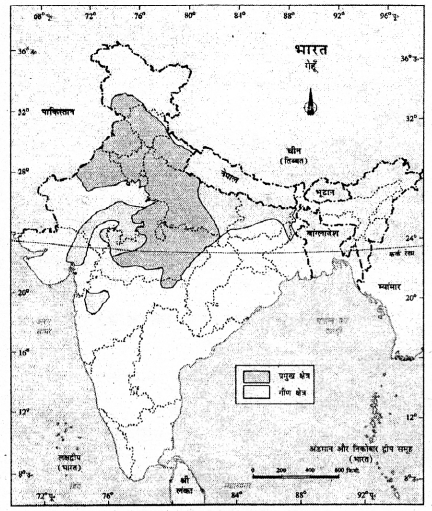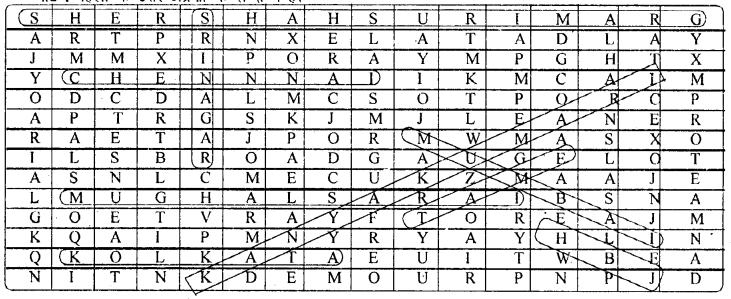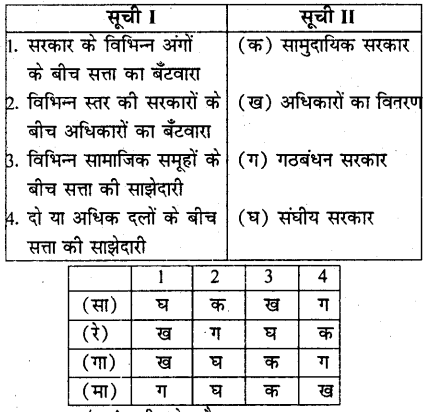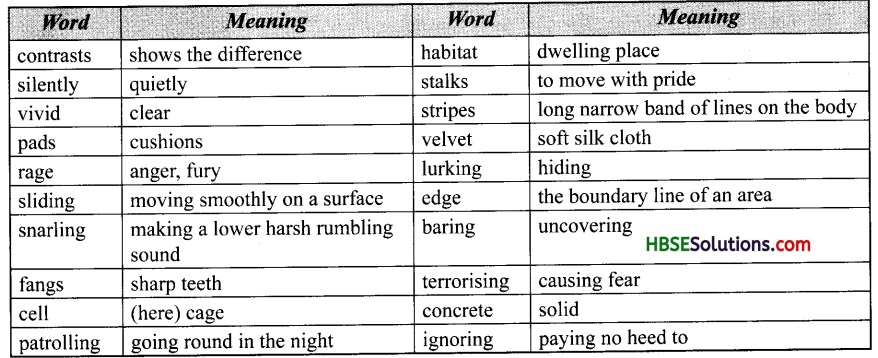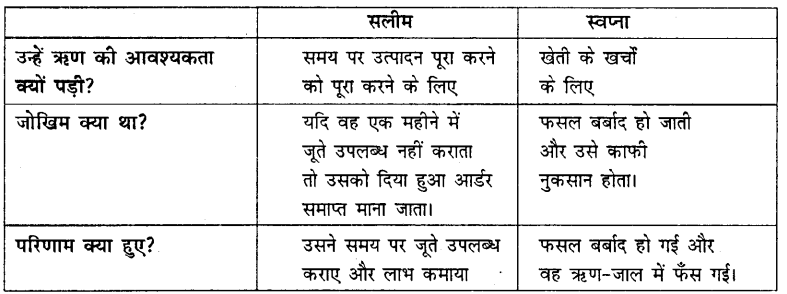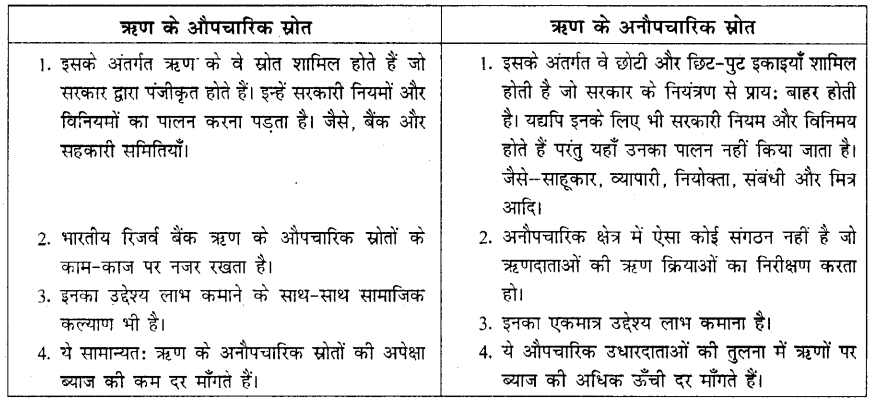Haryana State Board HBSE 10th Class Social Science Solutions Economics Chapter 2 Sectors of Indian Economy Textbook Exercise Questions and Answers.
Haryana Board 10th Class Social Science Solutions Economics Chapter 2 Sectors of Indian Economy
HBSE 10th Class Economics Sectors of Indian Economy Intext Questions and Answers
Let’s Work These Out (Page No. 21)
Sectors of Indian Economy Class 10 HBSE Economics Question 1.
Complete the Table 2.1 to show how sectors are dependent on each other.
Answer:
Table 2.1 : Examples of Economic Activities
| Example | What does this show? |
| Imagine what would happen if farmers refuse to sell sugarcane to a particular sugar mill. The mill will have to shut down. | This is an example of the secondary or industrial sector being dependent on the primary sector. |
| Imagine what would happen to cotton cultivation if companies decide not to buy from the Indian market and import all cotton they need from other countries. Indian cotton cultivation will become less profitable and the farmers may even go bankrupt if they cannot quickly switch to other crops. Cotton prices will fall. | This is an example of the primary sector. This shows dependence on the secondary sector. |
| Farmers buy many goods such as tractors, pump sets, electricity, pesticides and fertilizers. Imagine what would happen if the price of fertilizers or pump sets go up. The cost of cultivation of the farmers will rise and their profits will be reduced. | This example shows the dependence of primary sector on the secondary sector. |
| People working in the industrial and service sector need food. Imagine what would happen if there is a strike by transporters and lorries refuse to take vegetables, milk, etc. from rural areas. Food will become scarce in urban areas whereas, farmers will be unable to sell their products. | This example shows that the primary sector is dependent on the tertiary sector. |
Chapter 2 Sectors of Indian Economy HBSE 10th Class Question 2.
Explain the difference between primary, secondary and tertiary sectors using examples other than those mentioned in the text.
Answer:
Following are the differences among primary, secondary and tertiary sectors –
(1) Primary Sector – In this sector, goods are produced by utilization of natural resources.
For example:
wheat cultivation, fishing, forestry, mining, animal husbandry etc.

(2) Secondary Sector – This sector covers all those activities, which are performed to change natural products into other forms, through various ways of manufacturing.
For example:
furniture industry, cotton textile industry, iron and steel industry, engineering industry etc.
(3) Tertiary Sector – This sector covers all services, which help in the development of the primary and the secondary sectors. This sector is also called the service sector. For example – teachers, doctors, railways, lawyers, shopkeepers, trade, education, and health services etc.
HBSE 10th Class Economics Chapter 2 Sectors of Indian Economy Question 3.
Classify the following list of occupations under primary, secondary and tertiary sectors :
- Tailor
- Workers in match factory
- Basket weaver
- Moneylender
- Flower cultivator
- Gardener
- Milk vendor
- Potter
- Fishermen
- Bee-keeper
- Priest
- Astronaut
- Courier
- Call center employee
Answer:
Primary Sector – Flower cultivator, gardener, fishermen, bee-keeper, potter, basket weaver.
Secondary Sector – Workers in a match factory.
Tertiary Sector – Money lender, milk vendor, priest, astronaut, courier, call center employee, Tailor.
Question 4.
Students in a school are often classified into primary and secondary or junior and senior. What is the criterion that is used? Do you think this is a useful classification? Discuss.
Answer:
Students in a school are often classified into primary and secondary or junior and senior. The criterion of this classification is their education level, age group, mental development, etc. The children of classes from play group to 8, come under the junior category, and the children of classes 9 to 12 come under the senior category. Yes, I think this is a useful classification because the educational level, age group, and mental development of junior and senior students are different from each other.
Let’s Work These Out (Page 23)
Question 1.
What does the history of developed countries indicate about the shifts that have taken place between sectors?
Answer:
The history of the developed countries shows, that at the initial stage of development, the primary sector was the most important sector. Almost all the people were engaged in this sector. Gradually, new techniques of manufacturing were introduced and the secondary sector became important from the point of view of production and employment. But now, the tertiary sector has become the most important sector. Most of the working people are also employed in the tertiary sector or service sector. This is a general pattern observed in developed countries.

Question 2.
Correct and arrange the important aspects for calculating GDP from this Jumble. To count goods and services we add the numbers that are produced. We count all those that were produced in the last five years. Since we shouldn’t leave out anything we add up all these goods and services.
Answer:
We count the value of all those final goods and services that were produced in the particular year.
Let’s Work These Out (Page 24)
Answer the following questions by looking at the graph :
Question 1.
Which was the largest producing sector in 1973-74 ?
Answer:
The primary sector was the largest producing sector in 1973-74.
Question 2.
Which is the largest producing sector in 2013-14?
Answer:
The tertiary sector is the largest producing sector in 2013-14.
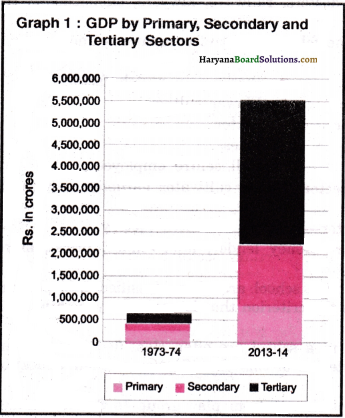
Question 3.
Can you say which sector has grown the most over forty years?
Answer:
The tertiary sector has grown the most over forty years.
Question 4.
What was the GDP of India in 2013-14?
Answer:
The GDP of India, in 2013-14, was ₹ 5,50,000 crore.
Let’s Work These Out (Page No. 27)
Question 1.
Complete the table using the data given in Graphs 2 and 3 and answer the question that follows.
Table 2.2 : Share of Primary Sector in GDP and Employment.
| 1973-74 | 1977-78 | 2013-14 | 2017-18 |
| Share in GDP | | | | |
| Share in employment | | | | |
What are the changes that you observe in the primary sector over a span of forty years?
Answer:
Table 2.2 : Share of Primary Sector in GDP and Employment
| 1973-74 | 1977-78 | 2013-14 | 2017-18 |
| Share in GDP | 40%. | — | 13% | — |
| Share in employment | – | 71% | – | 44% |
After studying this table, we have concluded, that over the span of forty years, the contribution of primary sector in GDP and employment is decreasing. The share of secondary and tertiary sector in GDP is increasing. Secondary and tertiary sectors are providing more employment to the people, in comparison to the primary sector in the last forty years, but the primary sector continues to be the largest employer, even now.
Question 2.
Choose the correct answer :
Underemployment occurs when people :
(i) do not want to work.
(ii) are working in a lazy manner.
(iii) are working less than what they are capable of doing.
(iv) are not paid for their work.
Answer:
(iii) are working less than what they are capable of doing.

Question 3.
Compare and contrast the changes in India with the pattern that was observed for developed countries. What kind of changes between sectors were desired but did not happen in India?
Answer:
In case of developed countries, the evolution of the economy happened on the most logical pattern, Growth in the primary sector was followed by a growth in the secondary sector. After that, the growth of the tertiary sector followed. The employment generation also kept pace with related changes in different sectors. The case of India is somewhat different.
The growth of the primary sector was not followed by the growth of the secondary sector, rather it was the tertiary sector which took the lead. But employment generation in either the secondary or tertiary sector could not keep pace. Still a larger number of people depend on the primar sector for employment, compared to the other two sectors. This shows a disturbing trer because the primary sector is beset with the problem of hidden unemployment.
Question 4.
Why should we be worried about underemployment?
Answer:
It is a situation, where people work at a job, which is below their capacity, skill and education. We should worry about underemployment because it may also result in an ineffective use of public resources. The earning capacity of a person is reduced, which results in poor standard of living and poverty.
Let’s Work These Out (Page No. 29)
Question 1.
Why do you think MNREGA 2005 is referred to as ‘Right to Work’?
OR
Why is the National Rural Employment Guarantee Act called ‘Right to Work’?
Answer:
MNREGA 2005 is referred to as ‘Right to Work’, because of some reasons, which are as follows :
- It guarantees 100 days of assured work to those people who are able, and want to do work.
- If the government fails in its duty to provide work, it will provide unemployment allowances to the people.
- 1/3 of the jobs are reserved for women.
Because of these reasons, it may be called “Right to Work”.
Question 2.
Imagine that you are the village head. In that capacity suggest some activities that you think should be taken up under this (MNREGA) Act that would also increase the income of people. Discuss.
Answer:
As a village head, I will give the following suggestions :
(i) Roads of village area should be constructed, so that laborers can get better employment opportunities, throughout the year. Better roads also help the farmers to bring their products in the local market.
(ii) Check dams, wells and canals should be constructed for irrigation.
Answer:
My neighbor, Mr. Mohan Lai, is a head clerk, in the office of the Block Elementary Education Officer. I have talked to him, as he is working in an organized sector. For the unorganized sector, I chose Mr. Bhagwat Singh, who works as a daily wages worker in a building construction company. On the basis of the conversation, I have compared their working conditions as follows
Working Conditions Of Mohan Lal:
- The working hours of Mohan Lai are fixed.
- Mohan Lai gets provident fund, medical allowance, paid holidays, pension and other allowances.
- Mohan Lai enjoys Saturdays and Sundays as paid holidays.
- When Mohan Lal joined work, he was given an appointment letter, which had ail the terms and conditions of work.
- Mohan Lai has security of job.
Working Conditions Of Bhagwat Singh:
- The working hours of Bhagwat Singh are not fixed.
- Bhagwat Singh does not get any other allowance, apart from his wages.
- Bhagwät Singh does not get any holiday or paid holiday.
- Bhagwat Singh was not given any such type of letter.
- Bhagwat Singh does not have security of job. He can be asked to leave the job anytime, by his employer.
Question 3.
How would you distinguish between organized and unorganized sectors? Explain in your own words.
Answer:
There are the following distinctions between organized and unorganized sectors:
| Ponits 0f Distinction | Organised sector: | Unorganised sector: |
| 1. Meaning | Organised sector covers thoseenterprises, where the terms ofemployment are regular andpeople have assured work. | Unorganised sector covers those small and scattered units, which are out of the control of the government. |
| 2. Rules and Regulations | Organised sector followsgovernment rules and regulatiofl8. | There are rules and regulations, but these are not followed. |
| 3. Terms of Employment Nature of Work | The terms of employment areregular. | The terms of employment are not regular. |
| 4. Salary | There is regular and assuredwork and employee cannot befired without any reason. | There is no security of work and employee can be fired without any reason. |
| 5. Working Hours | Employee and workers getsalary, regularly, at the end ofevery month. | Workers get daily wages. |
| 6. Other Benefits | The workers have fixed workinghours. | There are no fixed working hours. Even, workers do not get overtime for more work. |
| 7. Working Gonditions | If they work for morethan fixed working hours, theyget overtime. | There is no provision of any other benefit, except daily wages. |
| 8. Examples | Employees get provident fund,medical allowance, paid leave, pension etc. | in this sector, employees do not get such facilities. |
Question 4.
The table below shows the estimated number of workers in India in the organized and unorganized sectors. Read the table carefully. Fill in the missing data and answer the questions that follow:
Table 2.3 : Workers in Different Sectors (in Millions)
| Sector | Organised sector: | Unorganised sector: | Total |
| Primary | I | – | 232 |
| Secondary | 41 | 74 | 115 |
| Tertiary | 40 | 88 | 172 |
| Total | 82 | – | – |
| Total in Percentage | – | – | 100% |
(i) What is the percentage of people in the unorganized sector in agriculture?
(ii) Do you agree that agriculture is an unorganized sector activity? Why?
(iii) 1f we look at the country as a whole, we find that % of the workers in India are in the unorganized sector. Organised sector employment is available to only about % of the workers in India.
Answer:
Table 2.3 : Workers in Different Sectors (in Millions)
| Sector | Organised sector: | Unorganised sector: | Total |
| Primary | I | 231 | 232 |
| Secondary | 41 | 74 | 115 |
| Tertiary | 40 | 88 | 128 |
| Total | 82 | 393 | 475 |
| Total in Percentage | 17.26% | 82.74% | 100% |
(i) The percentage of people in unorganised sector in Agriculture is zero because as the proportion of agriculture sector people out of a total number of people in the unorganized sector is not mentioned over there so it means that the percentage is considered zero. Also, we can consider that people were not engaged in agriculture at that time.

(ii) Yes, I agree with this statement that agriculture is an unorganised sector activity, because there are no fixed working hours for workers, farmers or landless flirmers. They have no job security. Neither they get fixed wages, nor regular salary. They get low wages.
(iii) If we look at the country as a whole, we find that 82.74% of the workers in India, are in the unorganized sector. Organised sector employment is available to only about 17.26% of the workers in India.
Let’s Recall (Page No. 33)
With so many activities taking place around us, one needs to use the process of classification to think in a useful manner. The criterion for classification could be many depending on what we desire to find out. The process of classification helps to analyze a situation.
In dividing the economic activities into three sectors – primary, secondary and tertiary – the criterion used was the ‘nature of the activity. On the basis of this classification, we were able to analyze the pattern of total production and employment in India. Similarly, we divided the economic activities into organized and unorganized and used the classification to look at employment in the two sectors.
What was the most important conclusion that was derived from the classification exercises? What were the problems and solutions that were indicated? Can you summarise the information in the following table?
Table 2.4 : Classifying Economic Activities
| Sector | Criteria used | Most important conclusion | Problems indicated and how they can be tackled |
Primary,
Secondary,Tertiary | Nature of activity | | |
Organised,
Unorganised | | | |
Answer:
| Sector | Criteria used | Most important conclusion | Problems indicated and how they can be tackled |
Primary,
Secondary,
Tertiary | Nature of activity | The contribution of tertiary sector is the most in GDP. Most of the people are engaged in the primary sector. | The problem of disguised unemployment is found in agriculture. This problem can be sorted out, by increasing irrigation, transportation, loan facility, establishment of agro-based industries. |
Organised,
Unorganised | Conditions of job | Almost all the people of India are working in unorganised sector, where protection is needed. | The exploitation in unorganised sector can be eliminated, by government protection. |
HBSE 10th Class Economic Sectors of Indian Economy Textbook Questions and Answers
Question 1.
Fill in the blanks using the correct option given in the brackets :
(i) Employment in the service sector ……………. increased to the same extent as production. (has / has not)
(ii) Workers in the ………….. sector do not produce goods. (tertiary / agricultural)
(iii) Most of the workers in the …………… sector enjoy job security.(organised / unorganised)
(iv) A ………… proportion of labourers in India are working in the unorgamsed sector. (large / small)
(v) Cotton is a ………… product and cloth is a product. (natural / manufactured)
(vi) The activities in primary, secondary and tertiary sectors are …………. (independent / interdependent)
Answer:
(i) has not
(ii) tertiary
(iii) organised
(iv) large
(v) natural, manufactured
(vi) interdependent.

Question 2.
Choose the most appropriate answer.
(a) The sectors are classified into public and private sector on the basis of :
(i) employment conditions
(ii) the nature of economic activity
(iii) ownership of enterprises
(iv) number of workers employed in the enterprise.
Answer:
(iii) ownership of enterprises
(b) Production of a commodity, mostly through the natural process, is an activity in sector.
(i) primary
(ii) secondary
(iii) tertiary
(iv) information technology.
Answer:
(i) primary
(C) GDP is the total value of produced during a particular year.
(i) all goods and services
(ii) all final goods and services
(iii all intermediate goods and services
(iv) all intermediate and final goods and services.
Answer:
(ii) all final goods and services
(d) In terms of GDP, the share of tertiary sector in 2013-14 is between per cent.
(i) 20 to 30
(ii) 30 to 40
(iii) 50 to 60
(iv) 60 to 70.
Answer:
(iv) 60 to 70
Question 3.
Match the following :
| Problems faced by farming sector | Some possible measures |
| 1. Unirrigated land | (a) Setting up agro-based mills |
| 2. Low prices for crops | (b) Cooperative marketing societies |
| 3. Debt burden | (c) Procurement of food grains by government |
| 4. No job in the off season | (d) Construction of canals by the government |
| 5. Compelled to sell their grains to the local traders, soon after harvest | (e) Banks to provide credit with low interest |
Answer:
1. → (d)
2. → (c)
3. → (e)
4. → (a)
5. → (b)
Question 4.
Find the odd one out and say why.
(i) Tourist guide, dhobi, tailor, potter.
(ii) Teacher, doctor, vegetable vendor, lawyer.
(iii) Postman, cobbler, soldier, police-constable.
(iv) MTNL, Indian Railways, Air India, Sahara Airlines, All India Radio.
Answer:
(i) Tourist guide is the odd one because he comes under organised sector and follow the rules and regulations while others are often uneducated and fall under unurganised sector.
(ii) Vegetable vendor is the odd one, because he is comes in the category of unorganised sector. The others fall under the service and organised sector.
(iii) Cobbler is the odd one because he comes in the category of private sector/service sector as he provides personal service. Others are employed by the government and corne under public sector.
(iv) Sahara Airlines is odd one as it is owned by private individuals, while other are public or government sector enterprises.

Question 5.
A research scholar looked at the working people in the city of Surat and found the following:
| Place of work : | Nature of Employment | Percentage of working people |
| In offices and factories registered with the government | Organised | 15 |
| Own shops, offices, clinics in marketplaces with formal license | | 15 |
| People working on the street, construction workers, domestic workers | | 20 |
| Working in small workshops usually not registered with the government | | |
Complete the table. What is the percentage of workers in the unorganised sector in this city ?
Answer:
| Place of work : | Nature of Employment | Percentage of working people |
| In offices and factories registered with the government | Organised | 15 |
| Own shops, offices, clinics in marketplaces with formal license | Organised | 15 |
| People working on the street, construction workers, domestic workers | Un organised | 20 |
| Working in small workshops usually not registered with the government | Un organised | 50 |
The percentage of workers in the unorganised sector in this city is 70%.
Question 6.
Do you think the classification of economic activities into primary, secondary and tertiary is useful? Explain how.
Answer:
Yes, I think that the classification of economic activities into primary, secondary and tertiary sector is useful, due to the reasons as mentioned below :
- The classification of economic activities helps us as to know about how many people are engaged in the different sectors.
- This classification helps us to know about the share of each sector in the Gross Domestic Product (GDP) and in creating employment opportunities.
- This classification also helps to make planning by the government possible.
- Classification of economic activities into these three sectors helps in smooth economic administration and development.
- This type of classification helps in comparing the level of growth in different countries.

Question 7.
For each of the sectors that we came across in this chapter why should one focus on employment and GDP? Could there be other issues which should be examined? Discuss.
Answer:
In this chapter, we have studied, that economic activities are classified as primary, secondary and tertiary sectors, organised and unorganised sectors, and private and public sectors. Employment is a very important factor, as it sorts out many economic problems, like, poverty. On the other hand, GDP shows the contribution of each sector in the national income.
We should emphasise on the growth of employment and GDP in every sector, for satisfaction of present and coming future needs. There cannot be a prosperous economy, with prevailing unemployment, low per capita income and lower GDP. We can also examine some other issues related to human development, such as- education, health, availability of safe drinking water, sanitation, housing facilities, food, transportation, communication, insurance etc.
Question 8.
Make a long list of all kinds of work that you find adults around you doing for a living. In what way can you classify them? Explain your choice. ‘
Answer:
Adults, around me, are engaged in the following activities:
- Farming
- Fishing
- Forestry
- Mining
- Clerks
- Shopkeepers,
- Tailoring
- Hair cutting
- Communication
- Insurance
- Manufacturing
- Dairy
- Doctors
- Engineers
- Teachers
- Electricians
- Domestic servants
- Sweepers
- Washermen
- Factory owners
- Animal husbandry
- Weaving
- Transportation.
These activities are classified as follows:
- Primary sector – Farming, fishing, forestry, dairy, mining and animal husbandry etc.
- Secondary sector -Manufacturing, weaving, factory owners etc.
- Tertiary sector – Clerks, shopkeepers, tailoring, hair cutting, communication, insurance, doctors, engineers, teachers, electricians, domestic servant, sweepers, washermen, transportation etc.
Question 9.
How is the tertiary sector different from other sectors ? Illustrate with a few examples.
Answer:
Tertiary sector is different from the primary and secondary sectors. This sector provides the facilities regarding communication, banking, insurance, transportation etc. The tertiary sector is also called the service sector. The tertiary sector helps in the development of the primary and the secondary sectors. These activities, by themselves, do not produce any goods, but they help in the production process.
For example – goods produced in the primary and the secondary sector need to be transported by trucks or trains, and then, sold at wholesale or retail shops. Sometimes, produced items need to be stored in warehouses. We also need to talk to others on phone, or send letters, or borrow money from banks, to help production. So, we can say that the tertiary sector is the backbone of the other two sectors, i.e. it is very important for the other two sectors.

Question 10.
What do you understand by disguised unemployment? Explain with an example each from the urban and rural areas.
Answer:
Disguised unemployment is a type of unemployment, in which, people seem to be employed, but actually, they do not contribute towards productive activities.
Example from Urban Areas:
1° Urban areas, there ¿ire many people who are unemployed. Their job does not suit their qualification and experience.There are thousands of casual workers who reach for daily employment. They are employed as painters, plumbers, repair persons etc. Take an example – there is a small shop in a city, which requires only IWO persons for handling the shop, hut. three servants and one owner are engaged in this. It. shows that there are two servants, who are in the situation of disguised unemployment.
Example from Rural Areas:
In rural areas, it is generally found in agriculture sector. Number nl people engaged in farming, are generally more than required. Though it seems, that they are busy in the cultivation of land, but actually, they are partly employed. if some of them move out, production will not he affected. Take an example of a farmer who has a land of 3 hectare, which requires only 2 persons for farming related work, but all the seven family members are engaged in it. If 5 persons out of them are withdrawn from the job, the total production will not fall. Therefore, 5 persons will COIflC under the category of disguised unemployment.
Question 11.
Distinguish between open unemployment and disguised unemployment.
Answer:
These are following points of distinction between open unemployment and disguised unemployment:
Open Unemployment:
- An able-bodied person, willing to work, but does not get work, comes under open unemployment.
- It is permanent in nature.
- This type of unemployment is generally found in the industrial sector.
- It is found in the rural areas, among landless workers.
Disguised Unemployment:
- A person who seems to work, but in reality, he does not contribute towards production activities.
- It is temporary in nature. ‘
- This type of unemployment is generally found in the agricultural sector.
- In urban areas, this type of unemployment is found in small shops and small trades.
Question 11.
Distinguish between open unemployment and disguised unemployment.
Answer:
These are the following points of distinction between open unemployment and
Question 12.
“Tertiary sector is not playing any significant role in the development of Indian economy.” Do you agree? Give reasons in support of your answer.
Answer:
We do not agree with the statement that the tertiary sector is not playing a significant role in the development of Indian economy. Over the forty years, between 1973-74 and 2013-14, the production has increased the most, in the tertiary sector. In the year 2013-14, the tertiary sector had emerged as the largest producing sector in India. The contribution of tertiary sector in the Indian economy is as follows :
- Due to the new economic policy of Indian government, the tertiary sector has developed. The basic services, like – hospitals, educational institutions, transport, banks etc., are expanding. Number of persons employed in various new services, such as- internet cafes, ATM, call centres, software companies, are increasing.
- The contribution of tertiary sector has emerged as the largest producing sector in India, replacing the primary sector.
- The tertiary sector employs a large number of people.
- The tertiary sector helps in the development of the primary and secondary sector activities. For example: transportation, storage, communication, banking, trade, etc. These activities create services in place of goods. So, we can say that tertiary sector is playing an important role in the Indian economy.
Question 13.
Service sector in India employs two different kinds of people. Who are these?
Answer:
Service sector in India employs two different kinds of people. These are categorized as follows:
(i) Highly skilled and educated people: These include IT consultants, lawyers, teachers and financial advisors.
(ii) Mostly illiterate, semi-skilled and unskilled people: These include carpenters, plumbers, shopkeepers and transporters.

Question 14.
Workers are exploited in the unorganised sector. Do you agree with this view? Give reasons in support of your answer.
Answer:
Yes, I agree with this view that workers are exploited in the unorganised sector. The reasons are as follows :
- Unorganised sector does not follow government rules and regulations.
- In this sector, workers are engaged in low-paid jobs, which are often, not regular.
- There is no employment security.
- They have to work overtime, for which, they are not paid.
- There is no provision of paid leave, holidays, leave due to sickness etc.
- During some seasons, when the work load is less, then employer can ask some employees to leave the job.
- There is no job security.
Question 15.
How are the activities in the economy classified on the basis of employment conditions ?
Answer:
On the basis of employment conditions, the activities of the economy are classified into two sectors –
(i) Organised sector – This sector covers those enterprises, where the terms of employment are regular and they have assured work. Activities of organised sector are registered by the government and one has to follow its rules and regulations, which are given in various laws.
(ii) Unorganised sector – Small and scattered units, which are largely outside the control of the government, come under the unorganised sector. Although there are rules and regulations, but these are not followed.
Jobs in this sector are low paid, and often not regular. Employment is not secure and people can be asked to leave without any reason.
Question 16.
Compare the employment conditions prevailing in the organised and unorganised sectors.
OR
Explain five differences between organised and unorganised sector.
Answer:
Employment Conditions in Hie , Organised Sector:
- Organised sectors are registered by government.
- Organised sectors have to follow government rules and regulations.
- Jn this sector, workers are expected to work only for a fixed number of hours.
- Persons employed in this sector get monthly salary.
- Workers employed in this sector get several other benefits, such as- provident fund, various allowances, gratuity, pension etc.
- Workers of this sector enjoy security of employment.
- Workers of this sector get appointment letters.
- Availability of safe drinking water, electricity and, healthy working atmosphere.
Employment Conditions in the Unorganised Sector:
- Unorganised sectors are largely outside the control of the government.
- There are rules and regulations, but these are not followed.
- There is no certainty of working hours in this sector.
- Persons engaged in this sector get daily wages.
- Workers employed in this sector do not get any other benefit, except daily wages.
- There is no job security in this sector.
- Workers of this sector do not get any formal appointment letter.
- No availability of such types of facilities.
Question 17.
Explain the objective of implementing the NREGA 2005.
Answer:
The Central Government of India, made a law in the year 2005, implementing ‘Right to Work’, in selected 625 districts of India. It is called National Rural Employment Guarantee Act 2005 (NREGA 2005). The objective of implementing the NREGA 2005, is that, all those who are able to, and are in need of work, have been guaranteed 100 days of employment, in a year, by the government. If the government fails in its duty to provide employment, it will give unemployment allowance to the people.

At present, this law has been implemented in rural areas of all districts of the country, and is, at present, known as Mahatma Gandhi National Rural Employment Guarantee Act (MGNREGA). Under this act, those types of work have given preference, which would help to increase the production from land, in future. One-third of the proposed jobs would be reserved for women. It was started in the villages of 625 districts. It provides employment to rural people in the activities specified under the scheme. Thus, it helped to reduce the unemployed population of India.
Question 18.
Using examples from your area compare and contrast that activities and functions of private and public sectors.
OR
Differentiate between the public and the private sector. ((Y3SE .
Answer:
Differences between public and private Sector:
private Sector:
- In the private sector, ownership of assets and delivery of services are in the hands of private individuals or companies. For example – Tata Iron and Steel Company, Reliance Industries Ltd. DPS society.
- The motive of private sector is to earn profit.
- The decisions, regarding production and distribution, are taken by owners or managers of companies.
- Due to the motive of earning profits, it does not invest funds to construct structures and infrastructres of public utility.
- Services of this sector can be obtained only by payment.
public Sector:
- In the public sector, the government owns most of the assets and provides all the services. For example – Post Office, Indian Railways, Indian Airlines, All India Radio.
- The motive of public sector is to increase the facilities for public welfare.
- The decisions, regarding production and distribution, are taken by government.
- Due to the motive of public welfare, it invests funds to construct structures and infrastructure of public utility, e.g., construction of roads, bridges, canals, railways, harbours, dams, school and college buildings, generation of electricity etc.
- All citizens of a country can use and obtain services produced by this sector. unconditionally.
Question 19.
Discuss and fill the following table giving one example each from your area.
| WelI-m0aliaged organisation | Badly-managed organisation |
| Public sector | | |
| Private sector | | |
Answer:
| WelI-m0aliaged organisation | Badly-managed organisation |
| Public sector | Railways | Air India |
| Private sector | Tata Iron and Steel Company | Satyam |
Question 20.
Give a few examples of public sector activities and explain why the government has taken them up.
Answer:
Following are the examples of public sector activities :
- Indian Railways
- India Post,
- BSNL
- LIC
- AIIMS
- Electricity Department etc.
There are several necessities of a common man, but it is not possible for the private sector to provide all these things, at a reasonable cost. Some of these activities require large sums of money, which is beyond the capacity of private sector. Even if they provide these things, they would charge a high rate for their use. So, activities like construction of roads, dams, bridges, harbours, railways, hospitals, schools etc. are taken up by the government. The government provides these facilities to the people at lower cost.

Question 21.
Explain how public sector contributes to the economic development of a nation.
Answer:
Public sector contributes to the economic development of a nation in the following manner:
- Public sector helps in preparation of strong industrial base.
- It generates employment opportunities.
- It provides basic and essential facilities.
- It provides financial support for development.
- It provides all the necessary facilities, such as- food, clothes, housing and health facilities, at a reasonable rate.
- It encourages balanced regional development.
- It controls private monopoly in the economy.
- It establishes equality of income and property among people.
Question 22.
The workers in the unorganised sector need protection on the following issues : wages, safety and health. Explain with examples.
Answer:
(i) Wages – In the unorganised sector, workers have low paid jobs. They are often exploited. They are treated as bonded labour. They do not get any other allowance, except their daily wages. They do not get fair wages, annual increment, paid holidays etc. They should be given equal salary as given to the state government and central government employees. They should be given other allowances, such as- transportation, education, health and residence. They should be given annual increment.
(ii) Safety – In the unorganised sector, workers have no job safety or security because they can be asked to leave the job at any time, by their employer, without any reason. Since, they are generally engaged in many hazardous industries, like – mining, glass, cement, brick and crackers industries and under-construction works, they need protection. Every worker needs safety (security) of job. The procedure of leaving the job should be as per notice given by the worker and the worker should be given compensation for it. They should also be given compensation, while working in the industries or going on work or while returning to home after finishing work, such as the public sector, the state and central governments do.
(iii) Health – The workers engaged in the unorganised sector cannot take nutritional food due to low income. Therefore, their health status remains very poor. So, they need protection. Each employee should get health facilities during in-service period or after retirement. The working environment should be good, so that workers remain healthy, and work efficiently.
Question 23.
A study in Ahmedabad found that out of 15,00,000 workers in the city 11,00,000 worked in the unorganised sector. The total income of the city in this year (1997-1998) was ₹ 60,000 million. Out of this ₹ 32,000 million was generated in the organized sector. Present this data as a table. What kind of ways should be thought for generating more employment in the city?
Answer:
Table: Income and Employment in Organised and Unorganised Sectors in Ahmedabad (1997-98)
| Sector | No of Workers | Income (in mili jon) |
| Organised | 4,00,000 | 32,000 |
| Un organised | 11,00,000 | 28,000 |
| Total | 15,00,000 | 60.000 |
The above table shows, that 11,00,000 workers, out of 15,00,000 workers, are engaged in unorganised sector, but the income generated bv them is only ₹ 28,000 million. On the other hand, only 4,00,000 workers are engaged in the organised sector, but they generated more income (₹ 32,000 million), which is greater than the unorganised sector.
The methods that can be undertaken for generating more employment in the city of Ahmedabad are as follows :
- Government should encourage agro-based industries, in addition to small-scale industries and cottage industries.
- The government should avail loan facility on simple and easy conditions, as well as low interest rate.
- Labour-intensive techniques should be adopted, in place of capital-intensive techniques.
- Roads, bridges, dams, service roads, school buildings, residential colonies, commercial buildings should be constructed.
- Tertiary sector should be more developed. Banking services, health facilities, educational institutions, insurance facilities, transportation, communication, entertainment centres and financial facilities should be started by government and private sector.
Question 24.
The following table gives the GDP in rupees (crores) by the three sectors :
| Year | Primary | Secondary | Tertiary |
| 2000 | 52,000 | 48,500 | 13,3,500 |
| 2013 | 8,00,500 | 10,74,000 | 38,68000 |
(i) Calculate the share of the three sectors in GDP for 2000 and 2013
(ii) Show the data as a bar diagram similar to graph 2 in the chapter.
(iii) What conclusions can we draw from the bar graph ?
Answer:
(i) Share of sectors in GDP for 2000
Total GDP of three sectors = (52,000 + 48500 + 133500) = Rs 2,34,000 crore
Share of Primary Sector \(\frac{52,000}{2,34,000}\) x 100 = 22.22%
Share of Secondary Sector \(\frac{48,500}{23,4000}\) x 100 = 20.73%
Share of Tertiary Sector \(\frac{1,33,500}{2,34,000}\) x 100 = 57.05%

(b) Share of sectors in GDP for 2013
Total GDP of three sectors = 8,00,500 + 10,74,000 + 38,68,000 = Rs 57,42,500 crore
Share of primary sector
x 100 = 13.94%
Share of secondary sector
\(\frac{10,74,000}{57,42,500}\) x 100 = 18.7%
Share of tertiary sector
\(\frac{38,68,000}{57,42,500}\) x 100 = 67.36%
| Year | Share of the Primary Sector in GDP (in percentage) | Share of the Secondary Sector in GDP (in percentage) | Share of the Tertiary Sector in GDP (in percentage) |
| 2000 | 22.22 | 20.73 | 57-05 |
| 2013 | 13.94 | 18.7 | 67.36 |
(ii) Representation of the above data as a bar diagram:

(iii) Conclusions drawn from the bar diagram are:
(a) Share of primary sector in GDP has decreased.
(b) Share of secondary sector in GDP also decreased.
(c) Share of the tertiary sector in GDP has increased.
![]()
![]()
![]()
![]()
![]()
![]()
![]()
